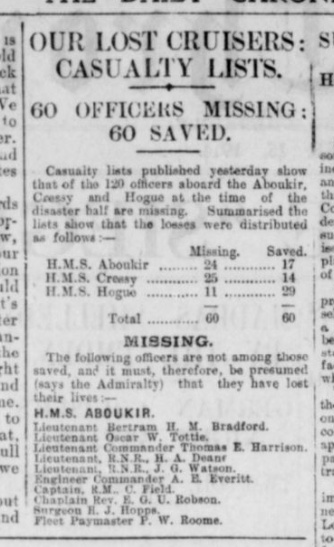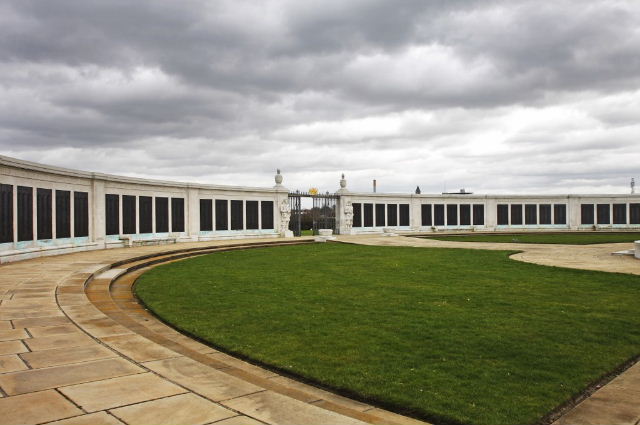Name
E (Edward) Gleadall Uphill Robson
Circa 1882
Conflict
First World War
Date of Death / Age
22/09/1914
32
Rank, Service Number & Service Details
Chaplain
Royal Navy
H.M.S. Aboukir
Awards: Service Medals/Honour Awards
Not Yet Researched
Cemetery/Memorial: Name/Reference/Country
CHATHAM NAVAL MEMORIAL
Panel 1
United Kingdom
Headstone Inscription
NA
UK & Other Memorials
Hitchin Town Memorial,
St Mary's Church Roll of Honour (Book), Hitchin,
Holy Trinity Parishioners Memorial, Caister On Sea Norfolk
Pre War
Wartime Service
He was an Acting Chaplain on H.M.S. ‘Aboukir’ which was sunk by torpedo. The ship was one of three old British cruisers sunk by the old German submarine U-9 commanded by the U-Boat ace Weddigen, twenty miles northwest of the Hook of Holland. The ‘Aboukir’ lost 25 officers and 502 men. The ship had been built in 1900 and was of 12,000 tons. It had no destroyer screen at the time and capsized in twenty-five minutes.
He was the first sea casualty from Hitchin. He survived the sinking of the ship and managed to reach a lifeboat. Due to heavy seas and the number of survivors, the boat overturned several times and he clung to its keel. The medical officer was also clinging to the boat attempting to hold an injured midshipman above the water. Eventually, he saw the chaplain turn blue and slip under the water, which may indicate that he died of exposure and possible heart failure. Those left were rescued by ships from Harwich and by fishing trawlers.
He has no known grave but is commemorated on the Naval Memorial to the Missing at Chatham.
Commander Bertram W. L. Nicholson submitted a report on the Sinking of the Cressy, Aboukir and Hogue:
Sir:
I have the honour to submit the following report in connection with the sinking of H.M.S. Cressy, in company with H.M.S. Aboukir and Hogue, on the morning of the 22nd of September, while on patrol duty.
The Aboukir was struck at about 6.25 a.m. on the starboard beam. The Hogue and Cressy closed and took up a position, the Hogue ahead of the Aboukir, and the Cressy about 400 yards on her port beam.
As soon as it was seen that the Aboukir was in danger of sinking all the boats were sent away from the Cressy, and a picket boat was hoisted out without steam up. When cutters full of the Aboukir's men were returning to the Cressy the Hogue was struck, apparently under the aft 9.2 magazine, as a very heavy explosion took place immediately. Almost directly after the Hogue was hit we observed a periscope on our port bow about 300 yards off.
Fire was immediately opened and the engines were put full speed ahead with the intention of running her down. Our gunner, Mr. Dougherty, positively asserts that he hit the periscope and that the submarine sank. An officer who was standing alongside the gunner thinks that the shell struck only floating timber, of which there was much about, but it was evidently the impression of the men on deck, who cheered and clapped heartily, that the submarine had been hit. This submarine did not fire a torpedo at the Cressy.
Capt. Johnson then manoeuvred the ship so as to render assistance to the crews of the Hogue and Aboukir. About five minutes later another periscope was seen on our starboard quarter and fire was opened. The track of the torpedo she fired at a range of 500 to 600 yards was plainly visible and it struck us on the starboard side just before the after-bridge.
The ship listed about 10 degrees to the starboard and remained steady. The time was 7.15 a.m. All the watertight doors, deadlights and scuttles had been securely closed before the torpedo struck the ship. All the mess stools and table shores, and all available timber below and on deck, had been previously got up and thrown over side for the saving of life.
A second torpedo fired by the same submarine missed and passed about 10 feet astern. About a quarter of an hour after the first torpedo had hit, a third torpedo fired from a submarine just before the starboard beam hit us under the No. 5 boiler room. The time was 7.30 a.m. The ship then began to heel rapidly, and finally turned keel up, remaining so for about twenty minutes before she finally sank, at 7.55 a.m.
A large number of men were saved by casting adrift on Pattern 3 target. The steam pinnace floated off her clutches, but filled and sank.
The second torpedo which struck the Cressy passed over the sinking hull of the Aboukir, narrowly missing it. It is possible that the same submarine fired all three torpedoes at the Cressy.
The conduct of the crew was excellent throughout. I have already remarked on the bravery displayed by Capt. Phillips, master of the trawler L.T. Coriander, and his crew, who picked up 156 officers and men.
Additional Information
Acknowledgments
Adrian Dunne, David C Baines, Jonty Wild, https://hampsteadparishchurch.org.uk/history-and-churchyards/war-graves/



